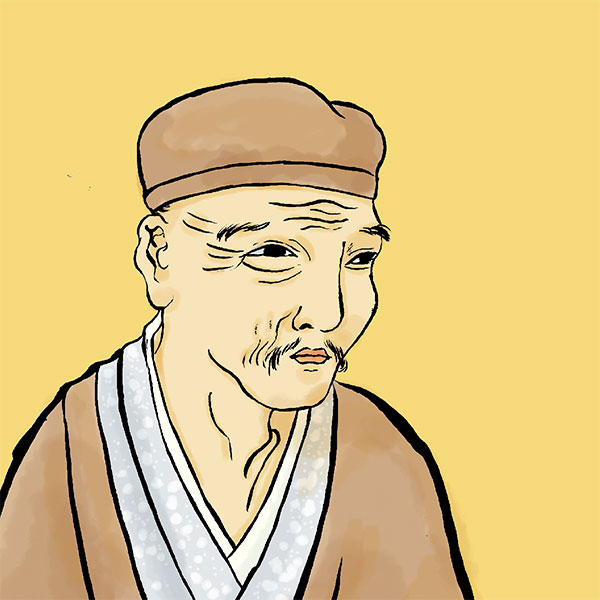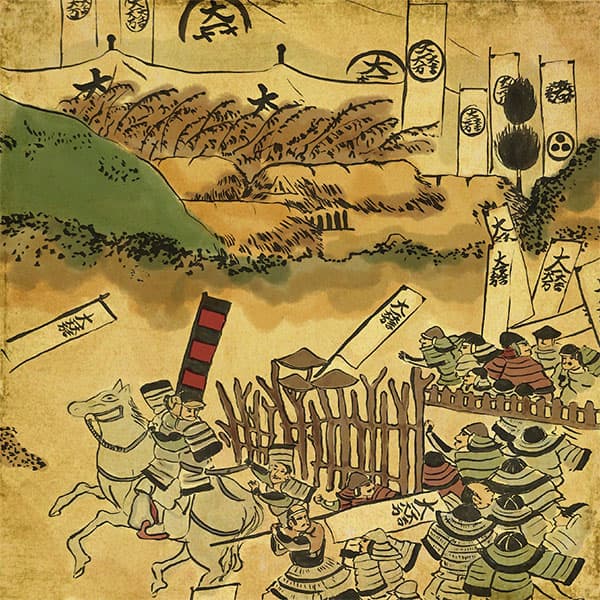Masatsugu Kobori (1/2)Father of Kobori Enshu, who was famous for his garden creation.

Masatsugu Kobori
- Article category
- biography
- name
- Masatsugu Kobori (1540-1604)
- place of birth
- Shiga Prefecture
- Related castles, temples and shrines

Bitchu Matsuyama Castle
Existing castle tower
Sunpu Castle

Nagoya Castle
- related incident
Even during the Sengoku period, which was filled with battles, the flower of culture flourished. Momoyama culture. Cultural leaders included Kano Eitoku, a painter, and Sen no Rikyu, a tea ceremony master. Following in the footsteps of Sen no Rikyu, Seiichi Kobori (Enshu) blossomed as a talent during the Edo period. Seiichi and his father, Masatsugu Kobori, were born in Omi Province and were military commanders who solidified their foothold through geographical and blood ties.
This time, I would like to take a look at Masatsugu Kobori and his son Seiichi.
Masatsugu Kobori's early life and history
Masatsugu Kobori was born in 1540 in Sakata District, Omi Province (present-day Nagahama City, Shiga Prefecture) as the eldest son of Masafusa Kobori. Although he grew up being called Shinsuke by those around him, he left home and became a monk when he was young.
However, one theory is that his father, Masafusa Kobori, served Isono Kasumune, who belonged to the Asai family. Because of this connection, Shoji Kobori also returned to secular life, changed from being a monk to a samurai, and began serving Kasumasa Isono, the son of Kasumune Isono and the lord of Sawayama Castle. He then married Kazumasa Isono's daughter.
However, Kazumasa Isono, who served him, was attacked by the Oda family in 1571 and surrendered. Masatsugu Kobori, who served Kazumasa, did not accept Kazumasa Isono, who had left the Azai family and joined the Oda family, so he became a priest again and became a monk.
However, Masatsugu Kobori, who became a monk, returned to secular life and returned from being a monk to a samurai. He served Hidenaga Hashiba, the younger brother of Hideyoshi Hashiba (later Hideyoshi Toyotomi), the lord of Nagahama Castle in Omi Province.
As the power of his older brother Hideyoshi expanded, Hashiba Hidenaga began to have territory in Kii Province (present-day Wakayama Prefecture) and then Yamato Province (present-day Nara Prefecture). Shoji was admired for his administrative abilities and began to serve Hidenaga Hashiba as a land inspector. Furthermore, after Hidenaga Hashiba's death, he served his older brother Toyotomi Hideyoshi and was appointed county head of Yamato, Izumi, and Kii provinces.
While becoming a monk and a samurai, Masatsugu Kobori served Kazumasa Isono, Hidenaga Hashiba, and Hideyoshi Toyotomi as an administrator. By the way, while considering this background, or even a little further down the line, Masatsugu Kobori will continue to expand his ties of place and blood ties.
Masatsugu Kobori married Kazumasa Isono's daughter.
In his later years, Kazumasa Isono quit being a samurai and returned to farming, but his children served Todo Takatora. Todo Takatora served Todo Takatora for a period of time after Masatsugu Kobori left Kazumasa Isono and became a monk, and through this connection, Kazumasa's children came to serve Todo Takatora.
Since Todo Takatora and Kobori Masatsugu were serving under Hashiba Hidenaga at the same time, Takatora's cousin, Todo Yoshimasa's daughter, was adopted by Takatora, and Kobori Masatsugu's eldest son, Kobori Seiichi (Enshu), was adopted by Takatora. I am married to
In this way, the Omi samurai, centered in the northern part of Omi Province, built relationships based on local ties, and later expanded their blood ties to survive the Warring States era. Masatsugu Kobori also expanded his blood ties through geographical ties and built up his position.
As the lord of Bitchu Matsuyama Castle
In 1598, Toyotomi Hideyoshi passed away. After Hideyoshi died, Masatsugu Kobori approached Tokugawa Ieyasu.
The Battle of Sekigahara occurs in 1600. Masatsugu Kobori joined the Eastern Army led by Tokugawa Ieyasu and participated in the conquest of Aizu. After the Battle of Sekigahara, Bicchu Matsuyama was given 14,000 koku and became a feudal lord. At the same time, he was also entrusted with the management of Tenryo, the territory under the direct control of the Shogunate in Bicchu.
Afterwards, he was admired for the high level of administrative ability he displayed while serving Hidenaga Hashiba, and was assigned to work on the construction of Fushimi Castle and survey the territory of the shogunate in Bicchu and Omi.
However, in 1604, on his way to Edo, he suddenly died in Fujisawa. Masatsugu Kobori passed away at the age of 64.
Masatsugu Kobori's estate, Bicchu Matsuyama, was inherited by his eldest son, Seiichi Kobori (Enshu), and was managed by the Kobori family until Seiichi was transferred to the Omi Komuro domain in 1619.
Masatsugu's child, Seiichi Kobori (Enshu)
Now, the Kobori family where Masatsugu Kobori passed away. Bitchu Matsuyama Castle was inherited by Shoji's eldest son, Seiichi Kobori. Seiichi Kobori. He is generally known as Kobori Enshu, and Enshu is another name for the official rank of Seiichi, ``Totomi no kami.''
He was the son of Shoji Kobori and Kazumasa Isono's daughter in 1579, and his childhood name was Sakusuke. When his father, Masatsugu Kobori, served Hidenaga Hashiba, he moved to Koriyama Castle in Yamato Province, which was ruled by Hidenaga.
Around this time, Hidenaga invited Sen no Rikyu's disciple, Soji Yamagami, to Koriyama Castle and studied under Sen no Rikyu, and Koriyama became a place where tea ceremony culture flourished. Seiichi grew up in this kind of environment, and at the urging of his father Seiji, he went to the Haruya Soen of Daitokuji Temple to practice Zen.
After Hidenaga Hashiba died, he became Hideyoshi's direct advisor and moved to Fushimi Castle in 1595. It was here that Seiichi studied under Furuta Oribe and learned the tea ceremony.
In 1604, when Seiichi was 26 years old, his father Shoji passed away.
From here on, he was ordered by the Shogunate to serve as a Sakuji Bugyo almost every year, and was responsible for projects related to the Imperial Court and the Shogunate, such as the renovation of the castle tower of Bicchu Matsuyama Castle, the repair of Sunpu Castle, the construction of the Nagoya Castle castle tower, and the Goyosei-in Imperial Palace. I went.
In 1619, he was transferred from Bitchu Matsuyama to the Omi Komuro domain, and was also ordered to serve as magistrate of Omi Province and Kyoto.
As a feudal lord who engaged in Sakuji Bugyo, he demonstrated his talent as an architect and gardener, and was also known in later generations as a tea master and calligrapher, and even after Seiichi's death, his sense of beauty remained in the Edo period. It has remained constant throughout the ages, and has even influenced flower arranging.
Kobori Enshu and the culture of the early Edo period
It is believed that Seiichi Kobori met Furuta Oribe around the time he became a direct advisor to Toyotomi Hideyoshi.
Furuta Oribe was a feudal lord of the Toyotomi and Tokugawa families, but he was also a cultural figure who devoted his efforts to making tea utensils, kaiseki utensils, architecture, and gardening, and studied under Sen no Rikyu. He was later counted as one of the ``Seven Philosophers of Rikyu''.
Oribe developed the tea ceremony together with Sen no Rikyu during the Azuchi-Momoyama period, and after Rikyu's death, he created a huge trend called ``Oribe taste.'' While Sen no Rikyu sought tranquility in his values, Oribe Furuta aimed for novelty by creating tools with a dynamic ``beauty of discontinuity''.
Seiichi Kobori studied under Oribe Furuta, and in the Edo period, after Oribe passed away, he inherited and developed the cultural values created by Sen no Rikyu and Oribe Furuta.
Seiichi Kobori's cultural values are expressed in the world of tea ceremony, and he expressed them with the term ``kireisabi.'' Incorporating ancient dynastic culture into the world of tea ceremony established by Rikyu and others, he sought values in a bright, generous, and lighthearted direction.
This sense of value can also be seen in Seiichi's works, where he favors the use of gorgeous cloisonne work. Cloisonné, which uses traditional designs such as flowers, birds and landscapes drawn using sophisticated techniques such as hammer hammering, in muted colors, was used for the furniture of constructed buildings and for hiding nails.
Furthermore, the values established by Seiichi Kobori are not limited to construction and tea ceremonies, but have been passed down to this day, including in flower arranging after his death.
Bitchu Matsuyama Castle
Bitchu Matsuyama Castle is a mountain castle located in Takahashi City, Okayama Prefecture. It is also called Takahashi Castle, but to avoid confusion with Matsuyama Castles of the same name in various places, including Matsuyama Castle in Ehime Prefecture, it is called Bitchu Matsuyama Castle.
It is one of the 12 existing castle towers that remain to this day, and the castle tower, double turret, and part of the earthen wall have been designated as important cultural properties. It is also considered one of Japan's three major mountain castles (Iwamura Castle (Iwamura-cho, Ena City, Gifu Prefecture), Takatori Castle (Takatori-cho, Nara Prefecture), Bitchu Matsuyama Castle (Takahashi City, Okayama Prefecture)), and was also selected as one of Japan's 100 Famous Castles. It is a famous castle.
- related incident

- WriterTomoyo Hazuki(Writer)I have loved history and geography since my student days, and have enjoyed visiting historical sites, temples and shrines, and researching ancient documents. He is especially strong in medieval Japanese history and European history in world history, and has read a wide range of things, including primary sources and historical entertainment novels. There are so many favorite military commanders and castles that I can't name them, but I especially like Hisashi Matsunaga and Mitsuhide Akechi, and when it comes to castles, I like Hikone Castle and Fushimi Castle. Once you start talking about the lives of warlords and the history of castles, there's a side of you that can't stop talking about them.






